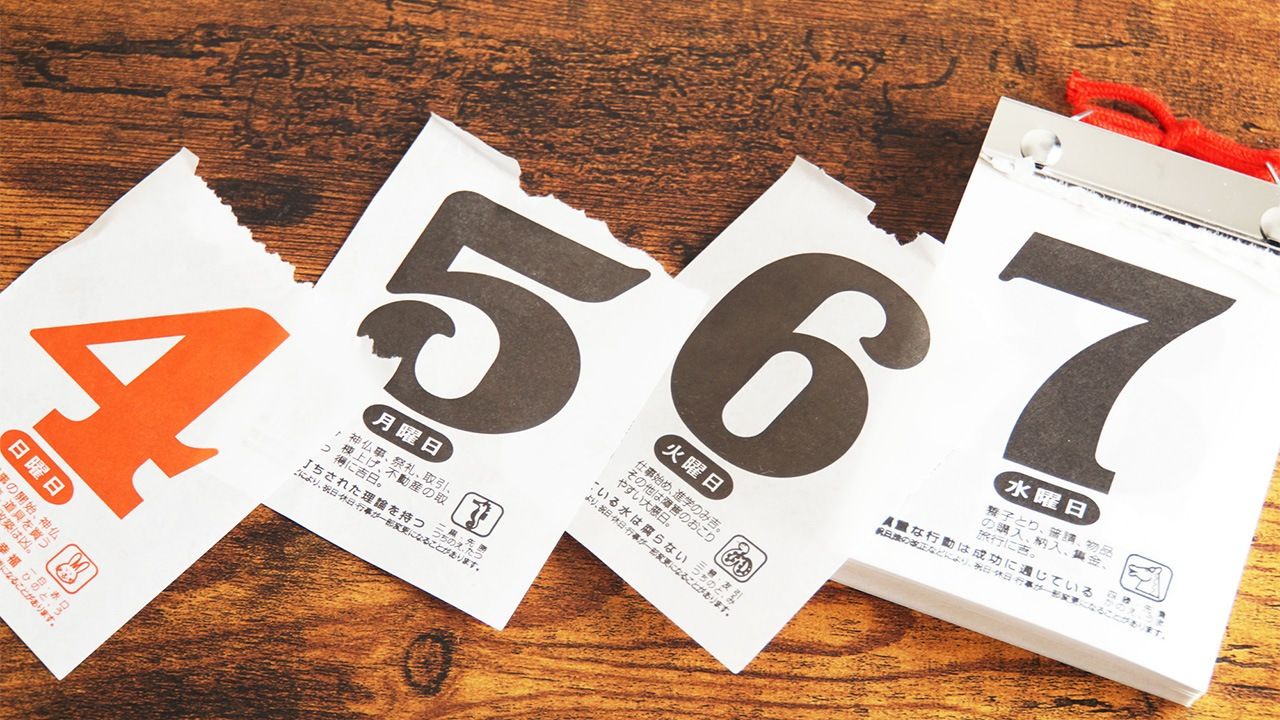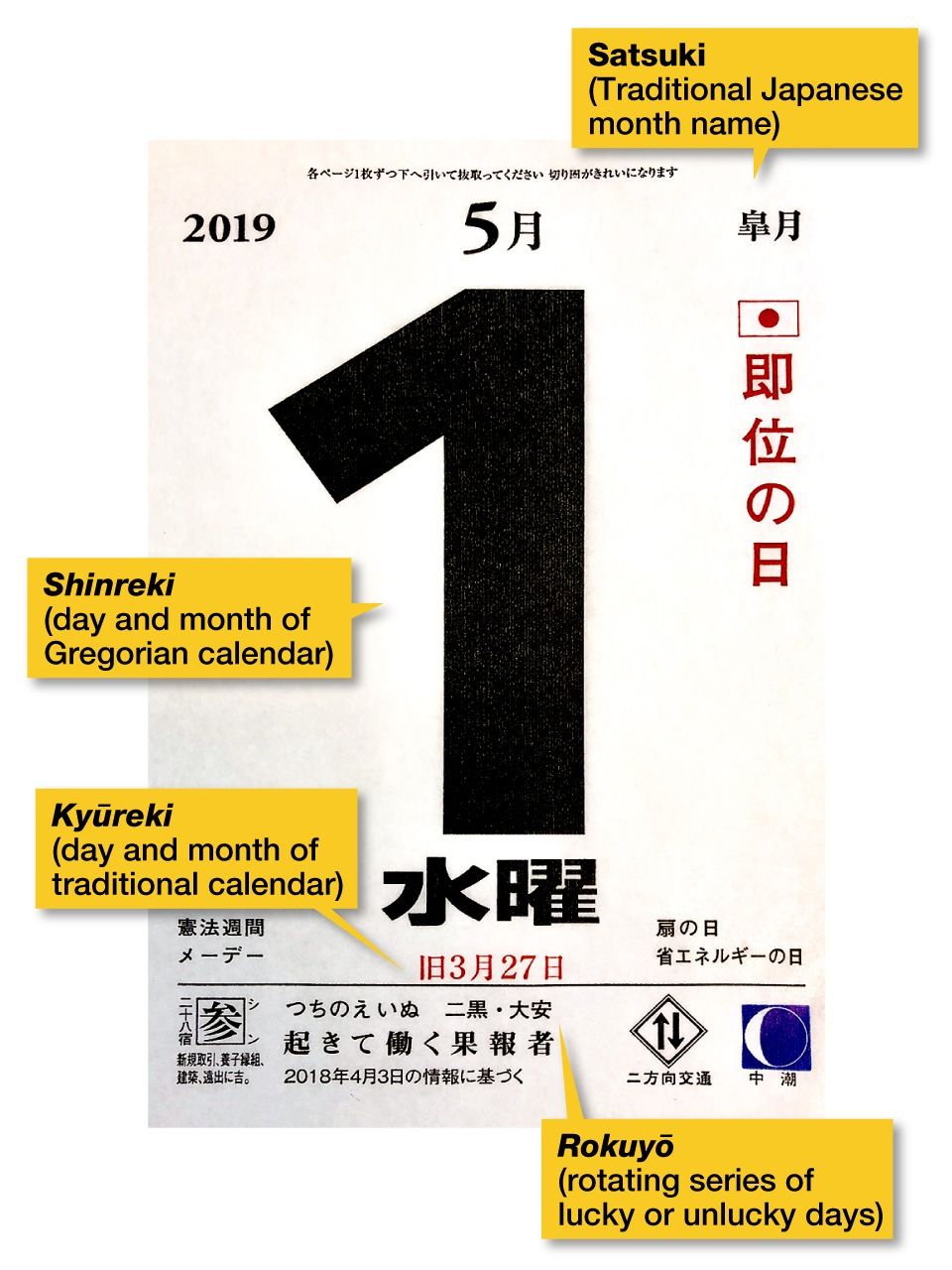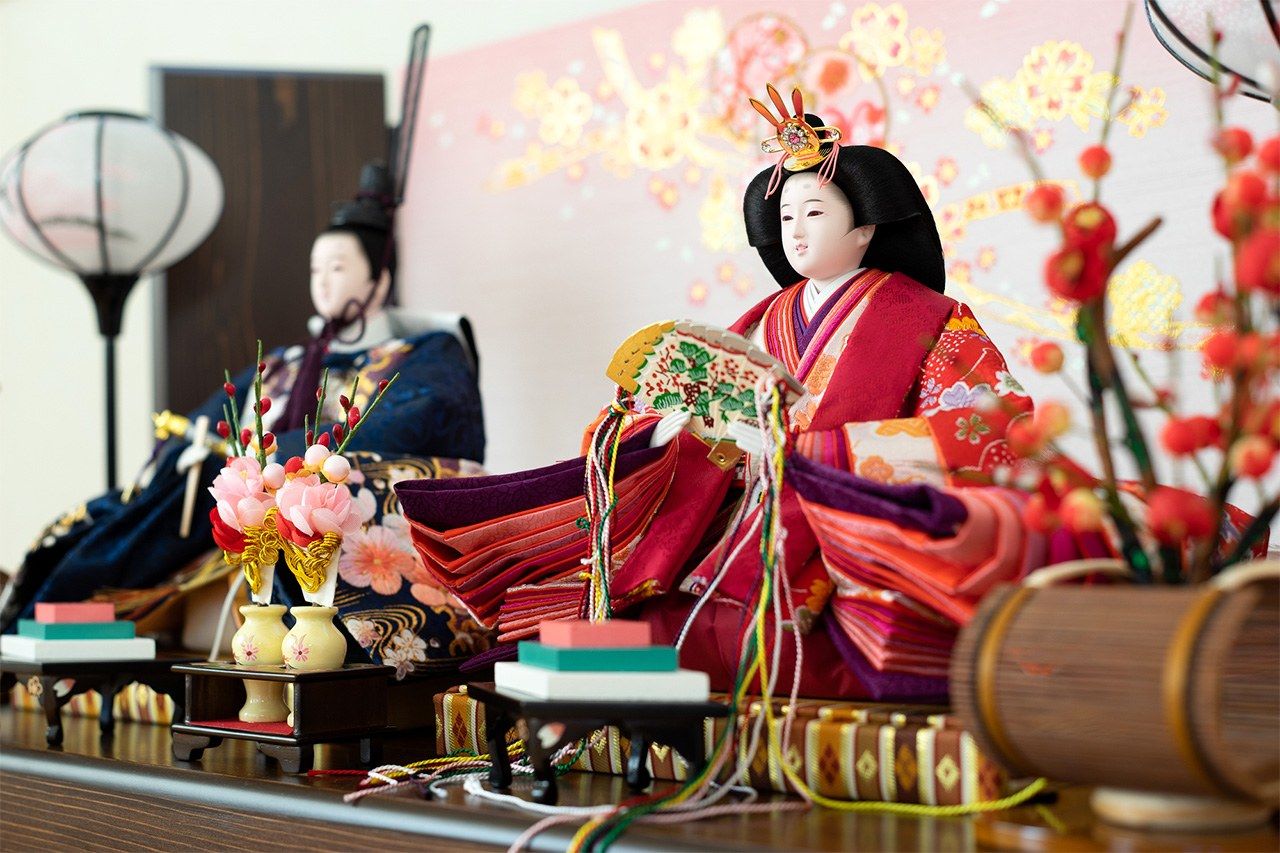
The Japanese Calendar
Culture Lifestyle History- English
- 日本語
- 简体字
- 繁體字
- Français
- Español
- العربية
- Русский
Japan is said to have drawn up its first calendar in 604, based on techniques developed in China and brought to its islands via the Korean Peninsula. Over the subsequent centuries, seasonal events and observances have filled out the traditional record of the year. Months in the former lunar calendar started when it was a new moon, while a full moon marked their midway point. As each year had only 354 days, it was sometimes necessary to add an intercalary month.
Although Japan adopted the standard Gregorian calendar in 1873, many aspects of its former calendar are still in use today. Some festivals are still held to match traditional dates, and calendar printers may include the latter on their publications.

A calendar for May 1, 2019, with several traditional features.
Era Names
Japan uses its own system of era names for denoting years alongside the international standard. For instance, the year 2018 was also Heisei 30, the thirtieth year of the Heisei era (1989–2019). The system was introduced in 645, and there have been 248 era names in total. Since 1868, there has been just one era name associated with each emperor, but historically they changed more frequently.
As Emperor Naruhito ascended to the throne on May 1, 2019, it is now the Reiwa era. This means that while January to April of 2019 was Heisei 31, May to December is Reiwa 1. After the new era name was announced on April 1, some publishers started selling calendars for the year with Reiwa included.
Eto: Zodiac Animals
The eto or zodiacal animals form a 12-year cycle. The system originally came from China and spread through other countries in the region, with slight variations in the animals used. In Japan, the order is rat, ox, tiger, rabbit, dragon, snake, horse, sheep, monkey, rooster, dog, and boar. Illustrations and photographs of the animals are prominent on New Year cards.
Traditional Names for Months
The 12 months of Japan’s traditional calendar were given informal names, which are still sometimes seen today. Each starts later than its equivalent in the Gregorian calendar—for example the first month begins in late January or in February. Even though the original seasonal associations behind some of the names do not exactly match the current system, it is not uncommon for them appear on calendars, as with Satsuki for May, as shown in the above picture.
| Month | Name | Believed original meaning |
|---|---|---|
| 1 | 睦月 (Mutsuki) | The month when family members gather for the New Year. |
| 2 | 如月 (Kisaragi) | The month of bundling up against the cold. |
| 3 | 弥生 (Yayoi) | The month of renewed growth of plants. |
| 4 | 卯月 (Uzuki) | The month when the deutzia blooms. |
| 5 | 皐月 (Satsuki) | The month of planting rice seedlings. |
| 6 | 水無月 (Minazuki) | The month of water, when farmers flood paddy fields. |
| 7 | 文月 (Fumizuki) | The month when rice ripens. |
| 8 | 葉月 (Hazuki) | The month of falling leaves. |
| 9 | 長月 (Nagatsuki) | The month when nights grow longer. |
| 10 | 神無月 (Kannazuki) | The godless month, when the kami of Japan are said to gather at Izumo Taisha Shrine in Shimane Prefecture. In Izumo, this is called Kamiarizuki, or “the month of gods.” |
| 11 | 霜月 (Shimotsuki) | The month of frost. |
| 12 | 師走 (Shiwasu) | The month when priests run around, making preparations for the New Year. |
The Five Sekku
The five sekku are seasonal festivals that take place on days deemed to be auspicious. On January 7 (jinjitsu no sekku), people eat nanakusa-gayu (seven-herb rice porridge), which was traditionally associated with prayers for good harvests and health in the year ahead. March 3 (momo no sekku) is the Hinamatsuri, a festival celebrating daughters, and May 5 (tango no sekku) is Boys’ Day, although the modern national holiday is known as Children’s Day. For Tanabata, or the star festival, on July 7 it is common to write and display wishes on colored paper. On September 9 (chōyō no sekku), the least well known of these festivals, chrysanthemums are commonly displayed at temples.

Dolls on display for Hinamatsuri on March 3.
The 24 Sekki: Subdivided Seasons
The 24 divisions of the year used in the Chinese calendar crossed over to Japan with some adaptations. Farmers once referred to these sekki when planning agricultural activities. The dates in the Gregorian calendar may vary by a day depending on the year. Japan also devised a calendar with each of the 24 sekki divided further into three kō, creating a total of 72 microseasons.
| Season | Date | Sekki | Meaning |
|---|---|---|---|
| Spring | February 4–18 | 立春 (Risshun) | Beginning of spring |
| February 19–March 5 | 雨水 (Usui) | Rainwater | |
| March 6–20 | 啓蟄 (Keichitsu) | Insects awaken | |
| March 21–April 4 | 春分 (Shunbun) | Spring equinox | |
| April 5–19 | 清明 (Seimei) | Pure and clear | |
| April 20–May 4 | 穀雨 (Kokuu) | Grain rains | |
| Summer | May 5–20 | 立夏 (Rikka) | Beginning of summer |
| May 21–June 5 | 小満 (Shōman) | Lesser ripening | |
| June 6–20 | 芒種 (Bōshu) | Grain beards and seeds | |
| June 21–July 6 | 夏至 (Geshi) | Summer solstice | |
| July 7–22 | 小暑 (Shōsho) | Lesser heat | |
| July 23–August 7 | 大暑 (Taisho) | Greater heat | |
| Autumn | August 8–22 | 立秋 (Risshū) | Beginning of autumn |
| August 23–September 7 | 処暑 (Shosho) | Manageable heat | |
| September 8–22 | 白露 (Hakuro) | White dew | |
| September 23–October 7 | 秋分 (Shūbun) | Autumn equinox | |
| October 8–22 | 寒露 (Kanro) | Cold dew | |
| October 23–November 6 | 霜降 (Sōkō) | Frost falls | |
| Winter | November 7–21 | 立冬 (Rittō) | Beginning of winter |
| November 22–December 6 | 小雪 (Shōsetsu) | Lesser snow | |
| December 7–21 | 大雪 (Taisetsu) | Greater snow | |
| December 22–January 4 | 冬至 (Tōji) | Winter solstice | |
| January 5–19 | 小寒 (Shōkan) | Lesser cold | |
| January 20–February 3 | 大寒 (Daikan) | Greater cold |
Rokuyō: Days of Fortune
The rokuyō is a repeated six-day sequence printed on some calendars that indicates whether each day is auspicious, particularly for activities like weddings and funerals.
Typical interpretation
| 先勝 (Senshō) | A good day for acting swiftly. The morning is auspicious, but the afternoon is unfavorable. |
| 友引 (Tomobiki) | Propitious for happy events, as you can “draw your friends” into their own similar experiences, but by the same token, funerals should be avoided. |
| 先負 (Senpu/Sakimake) | It is best to act calmly on this day. The morning is unlucky, but the afternoon is lucky. |
| 仏滅 (Butsumetsu) | Generally inauspicious, although it is fine to conduct funerals and Buddhist rites. |
| 大安 (Taian) | Generally auspicious. Especially good for weddings. |
| 赤口 (Shakkō/Shaku) | An unlucky day, particularly for celebrations. Only noontime is considered propitious. |
(Banner photo © Pixta.)